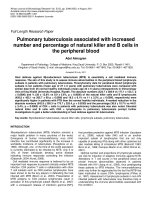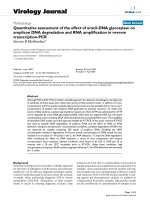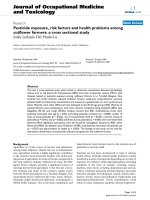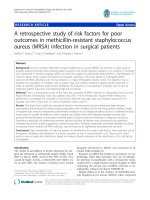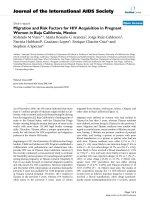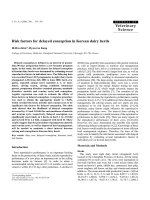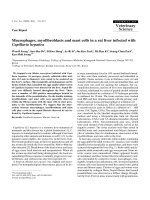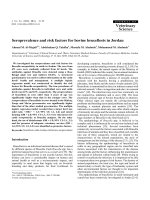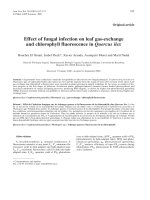Báo cáo y học: " Effect of Weight Reduction on Cardiovascular Risk Factors and CD34-positive Cells in Circulatio"
Bạn đang xem bản rút gọn của tài liệu. Xem và tải ngay bản đầy đủ của tài liệu tại đây (578.24 KB, 8 trang )
Int. J. Med. Sci. 2011, 8
445
I
I
n
n
t
t
e
e
r
r
n
n
a
a
t
t
i
i
o
o
n
n
a
a
l
l
J
J
o
o
u
u
r
r
n
n
a
a
l
l
o
o
f
f
M
M
e
e
d
d
i
i
c
c
a
a
l
l
S
S
c
c
i
i
e
e
n
n
c
c
e
e
s
s
2011; 8(6):445-452
Research Paper
Effect of Weight Reduction on Cardiovascular Risk Factors and
CD34-positive Cells in Circulation
Nina A Mikirova
, Joseph J Casciari, Ronald E Hunninghake, Margaret M Beezley
The Riordan Clinic, 3100 N, Hillside, Wichita, KS, USA
Corresponding author: Nina A Mikirova, 3100 N Hillside, Wichita, KS, 67219. Phone: 316-6823100 ext 253; Fax:
316-6825054, email:
© Ivyspring International Publisher. This is an open-access article distributed under the terms of the Creative Commons License (
licenses/by-nc-nd/3.0/). Reproduction is permitted for personal, noncommercial use, provided that the article is in whole, unmodified, and properly cited.
Received: 2011.07.01; Accepted: 2011.07.20; Published: 2011.08.01
Abstract
Being overweight or obese is associated with an increased risk for the development of
non-insulin-dependent diabetes mellitus, hypertension, and cardiovascular disease.
Dyslipidemia of obesity is characterized by elevated fasting triglycerides and decreased
high-density lipoprotein-cholesterol concentrations. Endothelial damage and dysfunc-
tion is considered to be a major underlying mechanism for the elevated cardiovascular
risk associated with increased adiposity. Alterations in endothelial cells and
stem/endothelial progenitor cell function associated with overweight and obesity pre-
dispose to atherosclerosis and thrombosis.
In our study, we analyzed the effect of a low calorie diet in combination with oral sup-
plementation by vitamins, minerals, probiotics and human chorionic gonadotropin
(hCG, 125-180 IUs) on the body composition, lipid profile and CD34-positive cells in
circulation.
During this dieting program, the following parameters were assessed weekly for all
participants: fat free mass, body fat, BMI, extracellular/intracellular water, total body
water and basal metabolic rate. For part of participants blood chemistry parameters and
circulating CD34-positive cells were determined before and after dieting.
The data indicated that the treatments not only reduced body fat mass and total mass
but also improved the lipid profile. The changes in body composition correlated with the
level of lipoproteins responsible for the increased cardiovascular risk factors. These
changes in body composition and lipid profile parameters coincided with the improve-
ment of circulatory progenitor cell numbers.
As the result of our study, we concluded that the improvement of body composition af-
fects the number of stem/progenitor cells in circulation.
Key words: weight reduction, body composition, cardiovascular risk factors, lipid profile, progen-
itor cells.
Introduction
Living in an environment characterized by calo-
rie-rich foods and low physical activity, over two
thirds of Americans are overweight [1]. This is a major
public health problem, as obesity predisposes to a
variety of age-related inflammatory diseases, includ-
ing insulin resistance, type 2 diabetes, atherosclerosis
and its complications, fatty liver diseases, osteoarthri-
tis, rheumatoid arthritis, and cancer [2-4]. Clinical
studies have identified a relationship between in-
creased body weight and cardiovascular disease in-
Ivyspring
International Publisher
Int. J. Med. Sci. 2011, 8
446
cluding coronary atherosclerosis, congestive heart
failure, arrhythmias, and stroke [5-11].
In addition to established cardiovascular risk
factors, systemic inflammation, increased oxidative
stress, and altered hemodynamics associated with
excess weight may directly contribute to endothelial
injury and dysfunction [12]. Progenitor cells, which
are released from the bone marrow are sensitive to
oxidative stress [13-16]. Circulating endothelial pro-
genitor cell (EPC) numbers have been found to be
lower in obese subjects compared to overweight or
normal weight adults, and the colony-forming capac-
ity of these cells is blunted [17, 18]. Alterations in en-
dothelial cells and EPC function associated with obe-
sity precede atherosclerosis and thrombosis [19-21].
Moreover, EPCs expanded from the obese subjects
possessed reduced adhesive, migratory,
and angio-
genic capacity [22] and fail to respond to vascular
endothelial growth factor. Mice treated with obese
EPCs exhibited
reduced EPC homing in ischemic hind
limbs in vivo.
Etiology of obesity is complex, involving inter-
related biochemical, neurological physiological, ge-
netic, environmental, cultural and psychological fac-
tors. Adipose tissue can be considered as an endocrine
organ that mediates biological effects on the metabo-
lism and inflammation, contributing to the mainte-
nance of energy homeostasis and the pathogenesis of
obesity-related metabolic and inflammatory compli-
cations [4]. Endothelial damage and dysfunction is
considered to be a major underlying mechanism for
the heightened cardiovascular burden that occurs
with increased adiposity.
The goal of our study was to examine how car-
diovascular risk factors and circulating CD34-positive
cell numbers correlate when overweight subjects at-
tempt to lose weight through calorie restriction. The
particular weight loss regimen we examined consisted
of severe calorie restriction along with vitamin sup-
plements and administration of human chorionic
gonadotropin (hCG), a hormone that encourages
metabolic utilization of visceral fat reserves [23-26].
Materials and Methods
Weight Loss Protocol
Our study consisted of fifty three participants,
eighty percent of which were women, with ages
ranging from 26 to 63. The starting body mass index
of these subjects ranged from 30 to 67, while their
body fat percentage ranged from 15% to 48% when
they began treatment. All subjects gave written in-
formed consent (as per Helsinki Declaration guide-
lines) and underwent the dietary program with the
oversight of their primary care physician. Although,
the program mainly aimed at overweight and obese
people, it was open to anyone interested.
The weight loss program consisted of a 500 calo-
rie per day dietary restriction in combination with the
following:
1. Daily sublingual treatments by vitamin B12
(1,000 g per day).
2. Oral supplements consisting of the following
nutrients: 250 mg tyrosine, 2 mg -glucan,
200 g selenium, 1 mg folic acid, 5 mg io-
dine, 7.5 mg potassium iodide, 600 mg
magnesium, 5 g vitamin D3, 60 mg coen-
zyme Q10, 150 mg lipoic acid, 340 mg ace-
tyl-l-carnitine, 100 mg vitamin B complex,
and a probiotic (2 billion CFU acidophilus
with 2 billion CFU bifidus and 109 mg FOS).
3. Daily treatments of hCG nasal spray, at
doses of 125 – 180 IU.
The very low calorie diet can be summarized as
follows: breakfast consisted of coffee/tea with no
sugar or one fruit serving, while lunch and dinner
each consisted of 3.5 oz lean protein, a vegetable
serving, bread serving, and a fruit serving. The pro-
gram schedule was as follows: patients took supple-
ments, B12, and hCG for two days prior to beginning
a 36-day very low calorie diet. This was followed by a
35 day maintenance period during which calorie in-
take was gradually raised while restricting sugar and
starch intake (at this point, hCG treatment stopped).
Subjects were supervised by a physician with
weekly health evaluations. The following parameters
were assessed weekly: body composition, including
fat free mass (FFM), body fat (BF), total body water
(TBW), intracellular/extracellular water, basal meta-
bolic rate and body mass index (BMI). Blood chemis-
try parameters, including glucose, cholesterols, tri-
glycerides and circulating CD34-positive cells were
measured for nine subjects at the beginning and at the
end of the study. Eight of the nine subjects who vol-
unteered for blood work were female: they ranged in
age from thirty to sixty-five years old. The lone male
was forty years old.
Assay methods are described below.
Body composition
Body composition was measured by bioelectrical
impedance analysis (BIA). The BIA is a non-invasive
method for measuring body composition through
reactance and resistance, the two components of im-
pedance. Bioelectrical impedance analysis was per-
formed by IMP DF50 (Company ImpediMed Lim-
ited). The fat–free mass, body fat, basal metabolic rate,
total body water, extracellular water, intracellular
Int. J. Med. Sci. 2011, 8
447
water and body mass index were determined for each
participant before dieting intervention and each six
days following intervention.
Assay of lipid profile
A fasting serum was used for measurements of
the lipid profile (total cholesterol, high-density lipo-
protein cholesterol (HDL), low-density lipoproteins
(LDL), triglycerides, very low-density lipoproteins
(VLDV)) and glucose, by established clinical labora-
tory tests. Cholesterol, HDL cholesterol, and triglyc-
erides were quantified
by an auto-analyzer by an en-
zymatic method by using commercially available re-
agents (Genzyme Diagnostics). LDL cholesterol (in
fasting samples) was determined by calculation.
CD34-positive cell measurements
The analysis of the CD34 positive cells was per-
formed by adopting the gating strategy defined by the
International Society of Haematotherapy and Graft
Engineering (ISHAGE) guidelines [27]. The method of
the selection of stem/progenitor cells consisted from
several criteria. Cells were selected that expressed
CD34+ antigen, did not express CD45 antigen and
exhibited low side-angle light scatter characteristics of
blasts cells. This subpopulation was defined as of
endothelial progenitor cells. Our decision to consid-
ered CD34 positive/CD45 negative circulating cells as
“circulating EPCs” was based on the work [28], in
which blood–derived cells from which endothelial
cells in culture were developed were described as
cells expressing CD34 antigen. It has been hypothe-
sized that endothelial progenitor cells and hemato-
poietic progenitor cells have common precursor, the
hemangioblast and both may be subsets of bone
marrow-derived progenitor cells expressing CD34.
Moreover, recent studies demonstrate that CD34+
cells not expressing leukocyte antigen (CD45-) form
endothelial colony-forming units and those express-
ing CD45 demonstrate hematopoietic properties [29].
Specific cell surface staining was accomplished
by incubating duplicate samples of a biological
specimen (separated white blood cells) with two color
CD45-FITC/CD34-PE reagents (Stem kit reagents,
Beckman Coulter). In an additional test, the samples
were stained with CD45-FITC/IsoClonic Control-PE
reagent to check the non-specific binding of the
CD34-PE monoclonal antibody.
Statistical analysis
All data were analyzed by Systat software (Sys-
tat Inc) and KaleidaGraph software. Variables were
presented as mean values ±SD. Statistical analysis was
done by linear regression model and paired
non-parametrical test. Statistical significance was ac-
cepted if the null hypothesis could be rejected at
p<0.05.
Results
The distributions of mass loss and fat mass loss
by all subjects during the diet are shown in Figure 1.
Figure 1. Distribution of the weight reduction and fat mass
loss in all subjects participated in 36 days of the dieting
program.
Subjects lost between 2.5 and 17.2 kg during the
study, with the most weight loss occurring in subjects
who started out the heaviest. All subjects achieved a
decrease in body mass index during the study. The
average BMI for participants at the start of the study
was 34.0 ± 7.2 (SD), while that after the study was 28.5
± 6.7 (SD). Using a paired Student’s t-test, the differ-
ence is highly significant (p = 0.0004). This indicates
that weight loss and changes in body composition did
occur during the time course of the study.
The weight reductions during the hypo-caloric
diet and maintenance period for several patients are
presented in Figure 2.
Changes in body composition parameters are
summarized in Table 1.
These percentages did not vary systematically
with the initial mass of the subjects. The decrease in
body fat was substantial, and in most cases larger than
the corresponding loss in lean mass. According to our
data, the average percentage loss of lean mass was
5.7±4.7 and the average change in body fat was
Int. J. Med. Sci. 2011, 8
448
12.4±8.7. The percentage loss in body fat among the
most subjects was significantly larger (p = 0.04) than
the percentage loss in lean mass, suggesting an im-
provement in body composition.
Figure 2. Examples of the effect of dieting and mainte-
nance periods on the weight loss for several participants.
Table 1. Percent of decrease in total mass, fat free
mass, intracellular/extracellular fluids and basal met-
abolic rate in subjects at the end of the study.
Parameter Mean
±SD
Minimum
value
Maximum
value
Weight kg 8.1±3.3 1.8 16.9
Total Body Water Liter 5.7±4.7 -3.2 16.1
Total Body Water % -2.6±4.1 -13.4 8.8
Intracellular Fluid Liter 5.7±6.3 -11.3 15.7
Intracellular Fluid % 0.0±3.0 -9.2 4.7
Extracellular Fluid
Liter
5.8±4.6 -4.0 18.0
Extracellular Fluid % 0.0±3.1 -5.1 9.2
Fat Free Mass kg 5.7±4.7 -3.4 16.1
Fat Free Mass % -2.6±4.2 -13.6 8.8
Fat Mass kg 12.4±8.7 -8.4 31.2
Fat Mass % 4.7±8.3 -11.2 26.7
Basal Metabolic Rate
Mj
3.9±2.0 0.0 10.1
Basal Metabolic Rate
CAL
4.1±2.0 0.9 10.1
Body Mass Index 8.1±2.0 2.0 16.9
The treated subjects showed a decrease in their
body mass index in an average of 8.1%±2.0%.
Changes in total body water had inverse corre-
lation with changes in fat mass (r=0.86) and positive
correlation with an increase in fat free mass (r=0.78).
The level of intracellular water (ICW) correlated with
fat mass and fat free mass changes during dieting.
Intracellular water levels showed linear relation with
fat free mass (r=0.9) and an inverse relation with fat
mass (r=0.6). As intracellular fluid decreases due to
different pathological conditions, the increase in in-
tracellular water suggests improvement in cell health
and nutritional status.
Basal metabolic rate decreased slightly in sub-
jects during their treatment (4.1%±2.0%). The per-
centage of the decrease in BMR correlated with the
percentage of weight loss. The decreasing of BMR is
not desirable for dieters; however, the BMR decrease
seen in our study is modest.
Statistically significant decreases in serum cho-
lesterol levels were observed during the treatment.
Lipid profile data are summarized in Table 2.
Table 2: Averaged blood chemistry parameters before
and after the diet regiment are given. † indicates sig-
nificant difference between “Pre” and “Post” (p < 0.05
using paired Student’s t-test).
Lipid profile Pre Post
Glucose (mg/dL) 91 ± 12 89 ± 7
Cholesterol (mg/dL) 206 ± 36 177 ± 24 †
Triglyceride (mg/dL) 119 ± 57 97 ± 36
HDL Cholesterol (mg/dL) 52 ± 13 52 ± 10
VLDL (mg/dL) 24 ± 11 19 ± 7
LDL(mg/dL) 130 ± 29 106 ± 21 †
Cholesterol / HDL 4.2 ± 1.2 3.5 ± 0.8 †
LDL / HDL 2.7 ± 0.9 2.1 ± 0.7 †
While glucose levels, triglycerides, very low
density lipoproteins (VLDL), and high density lipo-
proteins (HDL) were not affected, subjects saw sig-
nificant decreases in total cholesterol, low density
lipoprotein (LDL), and overall in ratios of cholesterol
and LDL to HDL. These variables are considered
markers of cardiovascular disease. HDL protects ar-
teries by transporting cholesterol away, while LDL
can be deposited on arterial walls and clog arteries.
Changes in the level of cholesterol and LDL for all
participants are shown in Figures 3, 4.
For total cholesterol, the upper limit of the nor-
mal range is 200 mg/dL. Five of the subjects started
the study above this threshold. All of these partici-
pants experienced cholesterol decreases during the
Int. J. Med. Sci. 2011, 8
449
diet treatment, with two returning completely to the
normal range. The upper limit of the normal range for
LDL is 100 mg/dL. Eight of the nine subjects started
with above normal LDL, with three of them returning
to normal levels during the treatment. Similar trends
were seen with the cholesterol/HDL ratio (upper
limit of normal being 5.0) and LDL/HDL (upper limit
of normal being 3.6).
Figure 3. The effect of the dieting program on the level of
LDL in plasma.
Figure 4. The effect of the dieting program on the level of
cholesterol in plasma.
Regression analysis was conducted between
body composition parameters and lipid profile pa-
rameters. The mass of body fat (BF) correlated
strongly with the LDL to HDL ratio (r = 0.7), the cho-
lesterol to HDL ratio (r=0.68) and inversely with HDL
(r = 0.43).
Overall, these data indicated that the combina-
tion of a low calorie diet with hCG treatments reduced
body fat as well as risk factors associated with cardi-
ovascular disease.
Circulating CD34+ cells in peripheral blood, as a
percentage of total leukocyte counts, were determined
before and after the study. Weight loss was accompa-
nied by a significant improvement in the number of
circulating progenitor cells (p < 0.01). On average, the
enhancement of progenitor cell numbers was roughly
seventy percent. Figure 5 shows how CD34+ cell lev-
els changed for each subject from the start to the end
of the weight loss program.
Figure 5. The improvement of CD34 positive cell number
after diet.
Figure 6 shows the correlation between circu-
lating CD34+ cell number (given here as the ratio of
the percentage of cells after the diet to the percentage
of cells before the diet) and the percentage of body fat
lost by each subject during the study.
A correlation also exists between CD34+ cells
and the proportion of fat free mass (r = 0.80) for each
subject. The changes in body fat, and the changes in
lipid profile parameters, coincide with improvements
in circulatory progenitor cell numbers.
To rule out the possibility that changing num-
bers of circulating CD34+ cells were simply part of an
overall change in circulating white blood cells, we ran
complete blood counts before and after treatment on
the nine subjects who consented to blood work.
Changes in blood cell counts with treatment varied
among the nine subjects, with five experiencing over-
all decreases (the maximum downward change was
thirty percent). All subjects showed a decrease in

